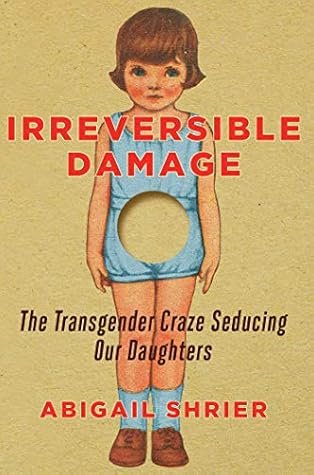More on this book
Community
Kindle Notes & Highlights
Within a year, Lucy had begun a course of testosterone. But her real drug—the one that hooked her—was the promise of a new identity.
Historically, it afflicted a tiny sliver of the population (roughly .01 percent) and almost exclusively boys. Before 2012, in fact, there was no scientific literature on girls ages eleven to twenty-one ever having developed gender dysphoria at all.
Between 2009 and 2017, the number of high schoolers who contemplated suicide increased 25 percent.8 The number of teens diagnosed with clinical depression grew 37 percent between 2005 and 2014. And the worst hit—experiencing depression at a rate three times that of boys—were teenage girls.9 Lest one assume that these girls are merely reporting their depression in greater numbers (and not necessarily experiencing more of it), Haidt points out that the average rates of self-harm reflect the same spike: an increase of 62 percent since 2009—all among teenage girls.10 Among preteen girls aged ten
...more
Puberty is also when today’s transgender craze among girls typically takes hold. Girls feel alienated from a body pummeling them from the inside. The stress brought on by puberty is age-old. What is new is today’s adolescents’ relative inability to bear it—and the constant presence of apparent alternatives. And then there is the mise-en-scène of our “quick fix” era—marked by the conviction that no one should ever endure any manner of discomfort. Ritalin for inattention; opioids for pain; Xanax for nerves; Lexapro for the blues; testosterone for female puberty. Adolescence is a long haul, and
...more
If “women” can no longer be defined according to physical characteristics or biology, how are we to define them? Prominent transgender author Andrea Long Chu has an answer: “Female is a ‘universal existential condition’ defined by submitting to someone else’s desires.”19 A more offensive or insipid definition of womanhood could hardly be imagined. But in order to redefine womanhood to include trans women, this sort of “solution” has become typical.
Meredith’s parents had no legal recourse against the Ivy League school they had hired to educate her, only despair over the course she had chosen, and a lingering sense of betrayal. So many adults were aiding Meredith’s medical transition, as if she were merely changing phone plans, not pursuing an irreversible course to disfigure her body. “I feel like we’re paying for them to ruin our daughter’s life,” Meredith’s mother told me. The school in question is the sort of place whose logo parents dream of placing on their car’s rear window. Now Meredith’s mother would prefer to watch the place
...more
Part of the answer lies with the Affordable Care Act of 2010, which indirectly forced health insurance companies to cover hormones and surgeries by barring health insurance companies from discriminating based on sexual orientation and gender identity. This meant that if insurance companies provided hormones (like birth control) to the non-transgendered, it had to also provide the expensive cross-sex version to the transgender-identified. If health insurance companies were going to cover breast reductions for anyone, they had also to cover double mastectomies for the gender dysphoric;
...more
The dangers are legion. The safeguards absent. Perhaps the greatest risk of all for the adolescent girl who grasps at this identity out of the blue, like it is the inflatable ring she hopes will save her, is also in some ways the most devastating: that she’ll wake up one morning with no breasts and no uterus and think, I was only sixteen at the time. A kid. Why didn’t anyone stop me?


